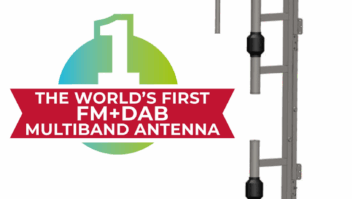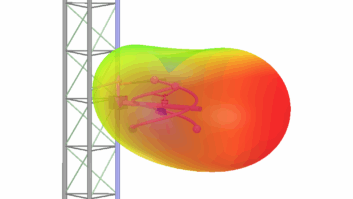You have probably heard the statement about standing wave ratio: “I changed the length of the transmission line and reduced the SWR.” Or the opposite statement, “I changed the length of the transmission line and the SWR increased.” Another statement we hear is, “I put a ‘trombone section’ in the transmission line and adjusted the length until the transmitter operated properly.”
Let’s consider what happens when the transmission line length is changed.
In my previous article “The ABCs of SWR, VSWR, Reflected Power and Return Loss” in the Dec. 9, 2015 issue, I described SWR as the standing wave ratio of forward and reflected power. (Read it at radioworld.com/swr.) The forward power travels towards the (antenna) load end of the transmission line. If the line is not terminated in the characteristic impedance of the line by a load (antenna), there will be a reflection that travels back toward the transmitter. These two traveling waves will interact with each other along the transmission line, in an interference pattern that creates standing waves. Depending upon the phase of the incident wave and the reflected wave, the interference may be constructive or destructive. The frequency of the wave and the length of the transmission line are fixed and unchanging, therefore the locations of the standing waves within the transmission line are fixed and unchanging as well.
Depending upon the type of the power metering in a transmitter system, the meter may be measuring the standing wave voltage at the test point, or it may be measuring the traveling waves. If the meter is measuring the standing wave voltage, that voltage will vary depending upon the sample point location along the transmission line. If the length of the transmission line is changed, the voltage at the sample point will change. If the meter is measuring the traveling waves, the location of the meter or the length the transmission line will not affect the meter reading. Bird Electronics and Coaxial Dynamics build power meters that measure the traveling wave.
MR. SMITH INVENTS A GRAPHIC
One of the better tools available to the broadcast engineer for troubleshooting SWR issues is the Smith chart invented by Phillip Hagar Smith in the 1930s. The Smith chart is a graphical representation of impedance, admittance (the reciprocal of impedance), phase, wavelength and the reflection coefficient. The Smith chart (Fig. 1) has groupings of circles and portions of circles.

The straight horizontal line through the center of the chart is the 0 reactance line. The line goes from zero resistance on the left side to infinite resistance on the right side.
The complete circles on the chart are the constant resistance circles. All points on a resistance circle have the same resistance. As the resistance value increases, the circle diameter gradually becomes smaller.
Reactance values are shown on the chart as the arcs of circles. All points on the reactance arc have the same reactance. As the reactance increases, the radius of the arc decreases. The point where the resistance circle and the reactance arc intersect represents a specific value of impedance, R+jX.
The outer ring is the wavelength scale. The scale is from 0 λ to 0.5 λ. If you move around the circle in a clockwise direction, you are moving towards the generator (transmitter). If you move in a counterclockwise fashion you are moving towards the load (antenna).
At the bottom of the chart are the SWR, Return Loss and other scales associated with reflections from the load.
FREELY CONVERT BETWEEN IMPEDANCE AND ADMITTANCE
One useful advantage of the Smith chart is the ability to work with either impedance (composed of resistance and reactance with the ohm, Ω, as the unit of measurement) or admittance (composed of conductance and susceptance with the siemens, S, as the unit of measurement). The chart readily converts from impedance to admittance.
You can also use mathematical formula for the conversions, B=susceptance, G=conductance, R=resistance, X=reactance, Y=admittance and Z=impedance.

The resistance and reactance values in a Smith chart are normalized so the standard resistance has a value of 1. This makes the chart usable for any impedance of transmission line.
Since the broadcast industry typically uses 50 ohm transmission line systems, all system measurements are divided by 50 ohms to obtain the normalized values for the chart. For 75 ohm systems, for example, one would normalize the values by dividing the measurements by 75 ohms.
One very important observation that can be made about the Smith chart is that everything repeats every one-half wavelength. That is, the impedance changes from low impedance on the left side of the chart to high impedance on the right side. This is easily demonstrated in a transmitter facility with high reflected power. The transmission line will have a physical hot spot every half wavelength due to high current resulting from the low impedance. Also every half wavelength there will be a high voltage point in the transmission line with the potential for an arc over because of the high impedance.
TAKING THE SMITH CHART ON AN EXERCISE
As an example of the useful value of a Smith chart, consider the following exercise. In the exercise, we must use the imaginary number j, defined as the square root of –1. Most broadcast transmitters are designed to operate into a 50+j0 ohm load, that is, the impedance is a real number (50 ohms) and the voltage is in-phase with the current. However, many antenna systems, especially systems with band pass or notch filters, may not have a 50+j0 ohm input impedance. This mismatch may cause some transmitters to operate improperly.
For instance, one model of 10 kW transmitter would operate properly into a 50+j0 ohm dummy load, but when the transmitter was connected to the antenna system, the transmitter tuning had to be drastically changed to permit the transmitter to operate. This happened even though the SWR of 1.12:1 was an acceptable value according to the transmitter manufacturer. To work out the cause and a solution, the input to the transmission line was measured with a vector network analyzer or VNA. The system measured 47.2–j4.75 ohms of reactance. The solution was to insert a piece of transmission line, cut to quarter-wavelength long, between the output power meter and the input to the antenna transmission line. The external power meter continued to show 1.12:1 SWR; the addition of the length of the transmission line did not affect the SWR, but it transformed the impedance of the transmission line input to a value that better matched the transmitter.
The Smith chart illustrates why the addition of the quarter wavelength piece of transmission line transformed the input impedance. When the above example’s transmission line impedance is plotted on a Smith chart (Fig. 2), it can readily be determined that the SWR is 1.12 through the following steps: The impedance was first normalized by dividing 47.2–j4.75 ohms by 50 ohms. The normalized value of 0.944–j.095 was plotted on the chart. The SWR circle that was drawn through this point confirmed the SWR of 1.12.

If the length of the transmission line is changed, the impedance will change, but it will remain on the SWR circle. Since 0.25 wavelength (λ) was added to the transmission line the impedance rotated around the SWR circle 0.25 λ. The value of λ at the initial impedance point was 0.084 λ. After the 0.25 λ was added, the new impedance point is now located at 0.334 λ on the SWR circle. The normalized value of this point on the Smith chart is 1.05+j.11. Multiple this value by 50 ohms to obtain the non-normalized value of 52.5+j5.5 ohms. This was proven by using the VNA to measure the transmission system again, and the VNA showed a value of approximately 53+j5 ohms.
TUNING A TRANSMISSION LINE SYSTEM, THE SMITH CHART WAY
The Smith chart can also be used to tune a transmission line system to have an input value of 50+j0 ohms even though the measured input is something other than 50+j0 ohms. For this exercise, assume that a radio station operating on 100 MHz had an antenna and transmission system with a SWR of 1.5:1. The transmission line is 3-1/8-inch rigid line with a velocity factor of 1. The system impedance at the input to the transmission line measures 60–j20 ohms. Assuming the velocity factor of the transmitted signal in a transmission line is around 11,760,000,000 inches per second, at 100,000,000 Hz the wavelength (λ) is 117.6 inches.

We are going use steatite doughnuts or slugs sold by ERI and others for the purpose of tuning antennas and transmission lines. The slugs have a specific value of susceptance depending upon the diameter of the transmission line. The slug for 3-1/8-inch line has a value of +j.214 siemens per inch of thickness.
The impedance is first normalized by dividing the measured impedance, 60–j20 ohms, by 50 ohms. For this section, refer to the steps in Fig. 3. The resulting value, 1.2–j0.4, is plotted on the Smith chart. In Step 2, draw a SWR circle with the center of the circle at the 1.0+J0 point on the chart and the circumference drawn through the plotted impedance. Step 3 requires that a straight line be drawn from the plotted impedance point, through the 1.0+j0 point to the wavelength scale. The admittance point is the intersection of the straight line with the SWR circle as seen in Step 4. This point should be 180 degrees around the circle from the impedance point. The plotted admittance value is 0.75+j0.25. (As a double check, the formula of

Now refer to Fig. 4 for the remaining steps. As part of step 5, note the value of λ on the wavelength scale (0.4261 λ). Because we will be locating a point closer to the load in the next step, we need to use the scale that is labeled “wavelengths toward load.” Next, in step 6, follow the SWR circle counterclockwise, towards the load, until the circle intersects with the 1.0 resistance circle in the inductive susceptance (lower half of the chart) region of the chart. For step 7, draw another straight line from the center of the SWR circle through the intersection of the SWR circle with the R=1.0 circle and continue the line to the wavelength scale. Note the value of the wavelength (0.142 λ). Since the wavelength scale passed through the starting point, 0.5 λ needs to be added to the 0.142 λ just noted to give us 0.642 λ. The total wavelength or distance from the previous admittance point to the new admittance point is 0.2159 λ. This wavelength value needs to be converted back to inches (0.2159 λ times 117.6 inches = 25.39 inches). The center of the slugs will need to be located at approximately 25.4 inches from the input of the transmission line.

From the Smith chart, we can see that the slugs will be located at the 1.0–j0.41 susceptance point in the transmission line. Since the susceptance of a slug 1 inch thick for 3-1/8-inch transmission line is 0.214 siemens we need approximately 1.9 inches of slug. We will need to compromise and use the closest standard thickness which is 1-7/8 inches (1.875 inches) of slugs. If this has been carefully done, the input to the transmission line will be much closer to a 50+j0.0 value.
Remember, that while the input to the transmission line has been changed to 50+j0, the systems SWR between the slugs and the load has not changed. The better solution would be to adjust tuning of the antenna or filter causing the high SWR.
FINALLY, CONSIDER THE RIGID LINE
I need to make one final observation about SWR and transmission line systems that many FM broadcast engineers do not encounter, but this is familiar to our colleagues in the television industry. The majority of FM transmission systems use semi-flexible transmission line such as Heliax cables. But for the systems that use rigid coax, the length of the sections of the line can play an important role in the amount of SWR in the system. Consider that for a frequency of 98 MHz, the wavelength is 120 inches. This means that if a system uses 20-foot lengths of rigid line, there will be a slight SWR bump every two wavelengths from the joints of the rigid line. These bumps will add up to produce a high VSWR for stations operating with frequencies near 98 MHz. The solution to this problem is to avoid the use of 20-foot long sections.
Mike Hendrickson, CPBE CBNT, has been a broadcast engineer for more than 45 years. He is the retired chief engineer of American Public Media Group in St. Paul, Minn.
REFERENCES
For more detailed information on the basis for the Smith Chart, visit:
http://www.ittc.ku.edu/~jstiles/723/handouts/2_4_The_Smith_Chart_package.pdf
http://www.microwaves101.com/encyclopedias/smith-chart-basics
For a history of the Smith chart and short biography of Phillip H. Smith see “P.H. Smith and the Smith Chart” by the Smith Chart Amateur Radio Society at: http://smithchart.org/phsmith.shtml







